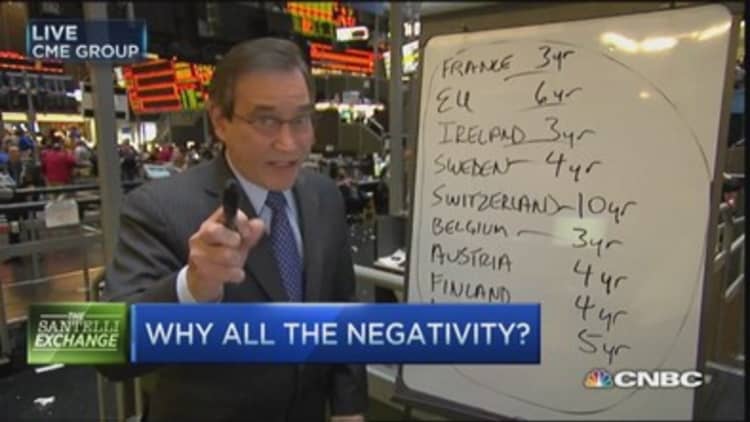
Professional investors and the mom-and-pop crowd have developed a starkly different view about which way stocks are heading.
The pros are strongly bullish while the retail side is at its most pessimistic in nearly two years, according to separate investor sentiment surveys that paint a puzzling picture of the market climate. (Tweet this)
In the most recent Investors Intelligence survey, the percentage of those bullish actually increased to 56.6 percent from 52 percent in the previous week's sampling period. That contrasted against just 14.1 percent on the bearish side, a number that has remained pretty constant over the past four weeks.
Investor Intelligence takes the temperature of newsletter authors and is thus considered a gauge of professionals.
In contrast, the American Association of Individual Investors survey showed bulls all the way down to 27.2 percent. That number was the worst since April 2013, just as the was setting up for a dip of more than 7 percent in only a month's time. That bullish reading was off 4.4 percentage points from the previous week's reading.
AAII bears—or those who believe the index will be below its current level in six months—increased to 31.5 percent, a gain of 6.1 percentage points. Neutral sentiment fell 1.6 percentage points to 41.4 percent, well above its historical norm of 30.5 percent.
Unusually low bullish and unusually high neutral sentiment levels coincide with better-than-average market performance in ensuing six- and 12-month periods, according to Charles Rotblutt, editor of the AAII Journal and vice president of the organization.
Investors face three challenges in the current landscape: A weakening economy that may see first-quarter gross domestic product growth of less than 1 percent; deteriorating corporate earnings that could see an annualized profit loss on the S&P 500 for 2015; and a Federal Reserve expected to tighten monetary policy at a time when its central bank counterparts around the world are loosening, leading to a stronger dollar.
"We've seen so much volatility in the last six months that I think we're almost inured to a three-, four-, five-hundred-point drop in the Dow, and then recover three days later," said Diane de Vries Ashley, a corporate finance instructor at Florida International University. "As a result, you don't necessarily have any rational thought that accompanies that. Where that leaves us follows a little bit of what our friends at the Fed are doing. They're of a seesaw mindset, too."
Read MoreSomething'stroubling about the market: Trader
The declining profits presents an especially nettlesome problem.
The S&P 500's rally off its March 2009 lows can be traced both to extreme easing from the Fed and a recovering profit picture from the crisis bottom. Should the earnings engine stall, as it appears to be doing at least judging by analyst estimates, then further stock market gains could be hard to achieve.
"We've updated our earnings forecast several times in the last few months ... we haven't been able to keep up," said Dan Suzuki, senior U.S. equity strategist at Bank of America Merrill Lynch. "Given that currencies are where they are, that's provided significant downside to our numbers, which call for flattish growth."
Indeed, the S&P 500 now is expected to show just 0.3 percent profit growth for the full year, down from 8.6 percent expected as recently as Dec. 1, according to S&P Capital IQ.
Read MoreProfit recession: This is what you need to know
One consolation is that most of the weakness is coming from energy stocks, which as a sector make up just 7.8 percent of the S&P 500. The extreme expectations for loss—a 62.5 percent annualized drop in the first quarter alone and about the same in Q2—are playing a disproportionate role in the poor earnings picture.
"Ex-energy, the rest of the sectors are seeing mid-single-digit growth," Suzuki said. "It's a very industry-specific dynamic. It's not telling you the (growth) cycle is over."
Still, in the past profit recessions and economic recessions often have gone hand in hand.
Money movement recently has reflected the unease. Equity funds overall netted about $14 billion last week, but there was a huge divide: Exchange-traded funds, primarily the playing field of institutional investors, took in $18 billion, but mutual funds, which are more the territory of the retail side, lost $4 billion, according to BofAML data.
"I know some very canny retail investors who are in major Zen mode at this point," de Vries Ashley said. "Most ignore what so-called professionals are doing and go much more with their own thinking, or, if they're really honest, what their gut is telling them. To me, this is a go-with-your-gut kind of market."






